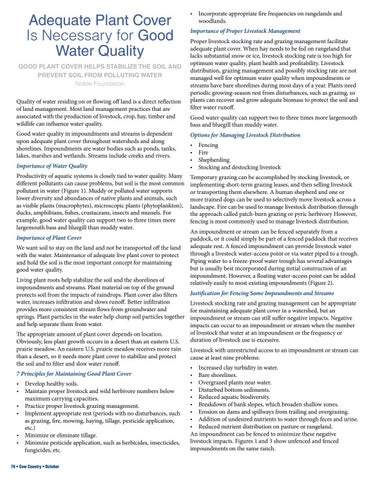Adequate Plant Cover Is Necessary for Good Water Quality GOOD PLANT COVER HELPS STABILIZE THE SOIL AND PREVENT SOIL FROM POLLUTING WATER Noble Foundation Quality of water residing on or flowing off land is a direct reflection of land management. Most land management practices that are associated with the production of livestock, crop, hay, timber and wildlife can influence water quality. Good water quality in impoundments and streams is dependent upon adequate plant cover throughout watersheds and along shorelines. Impoundments are water bodies such as ponds, tanks, lakes, marshes and wetlands. Streams include creeks and rivers. Importance of Water Quality Productivity of aquatic systems is closely tied to water quality. Many different pollutants can cause problems, but soil is the most common pollutant in water (Figure 1). Muddy or polluted water supports lower diversity and abundances of native plants and animals, such as visible plants (macrophytes), microscopic plants (phytoplankton), ducks, amphibians, fishes, crustaceans, insects and mussels. For example, good water quality can support two to three times more largemouth bass and bluegill than muddy water. Importance of Plant Cover We want soil to stay on the land and not be transported off the land with the water. Maintenance of adequate live plant cover to protect and hold the soil is the most important concept for maintaining good water quality. Living plant roots help stabilize the soil and the shorelines of impoundments and streams. Plant material on top of the ground protects soil from the impacts of raindrops. Plant cover also filters water, increases infiltration and slows runoff. Better infiltration provides more consistent stream flows from groundwater and springs. Plant particles in the water help clump soil particles together and help separate them from water. The appropriate amount of plant cover depends on location. Obviously, less plant growth occurs in a desert than an eastern U.S. prairie meadow. An eastern U.S. prairie meadow receives more rain than a desert, so it needs more plant cover to stabilize and protect the soil and to filter and slow water runoff. 7 Principles for Maintaining Good Plant Cover • Develop healthy soils. • Maintain proper livestock and wild herbivore numbers below
maximum carrying capacities.
• Practice proper livestock grazing management. • Implement appropriate rest (periods with no disturbances, such
as grazing, fire, mowing, haying, tillage, pesticide application, etc.) • Minimize or eliminate tillage. • Minimize pesticide application, such as herbicides, insecticides, fungicides, etc. 78 • Cow Country • October
• Incorporate appropriate fire frequencies on rangelands and
woodlands.
Importance of Proper Livestock Management Proper livestock stocking rate and grazing management facilitate adequate plant cover. When hay needs to be fed on rangeland that lacks substantial snow or ice, livestock stocking rate is too high for optimum water quality, plant health and profitability. Livestock distribution, grazing management and possibly stocking rate are not managed well for optimum water quality when impoundments or streams have bare shorelines during most days of a year. Plants need periodic growing-season rest from disturbances, such as grazing, so plants can recover and grow adequate biomass to protect the soil and filter water runoff. Good water quality can support two to three times more largemouth bass and bluegill than muddy water. Options for Managing Livestock Distribution • • • •
Fencing Fire Shepherding Stocking and destocking livestock
Temporary grazing can be accomplished by stocking livestock, or implementing short-term grazing leases, and then selling livestock or transporting them elsewhere. A human shepherd and one or more trained dogs can be used to selectively move livestock across a landscape. Fire can be used to manage livestock distribution through the approach called patch-burn grazing or pyric herbivory However, fencing is most commonly used to manage livestock distribution. An impoundment or stream can be fenced separately from a paddock, or it could simply be part of a fenced paddock that receives adequate rest. A fenced impoundment can provide livestock water through a livestock water-access point or via water piped to a trough. Piping water to a freeze-proof water trough has several advantages but is usually best incorporated during initial construction of an impoundment. However, a floating water-access point can be added relatively easily to most existing impoundments (Figure 2). Justification for Fencing Some Impoundments and Streams Livestock stocking rate and grazing management can be appropriate for maintaining adequate plant cover in a watershed, but an impoundment or stream can still suffer negative impacts. Negative impacts can occur to an impoundment or stream when the number of livestock that water at an impoundment or the frequency or duration of livestock use is excessive. Livestock with unrestricted access to an impoundment or stream can cause at least nine problems: Increased clay turbidity in water. Bare shorelines. Overgrazed plants near water. Disturbed bottom sediments. Reduced aquatic biodiversity. Breakdown of bank slopes, which broaden shallow zones. Erosion on dams and spillways from trailing and overgrazing. Addition of undesired nutrients to water through feces and urine. Reduced nutrient distribution on pasture or rangeland. An impoundment can be fenced to minimize these negative livestock impacts. Figures 1 and 3 show unfenced and fenced impoundments on the same ranch. • • • • • • • • •
















